The Daily Scrum is a time-boxed meeting which lasts 15 minutes. Following the tradition of Extreme Programmers (XP), most Scrum teams stand for the duration. Standing helps keep the meeting short and to the point because you're less likely to chat.
Here, your team gathers around the Scrum Board, as shown in the following figure:

Each Development Team member takes it in turns to answer the following three questions:
- What did I do yesterday that helped the Development Team meet the Sprint Goal?
- What will I do today to help the Development Team meet the Sprint Goal?
- Do I see any impediment that prevents the Development Team, or myself, from meeting the Sprint Goal?
One way for a team member to communicate what they are working on is for them to stand next to the board and point to the User Story or task.
For the very first Daily Scrum, you probably won't need the first question, unless you've already started work on meeting the Sprint Goal.
In the first Daily Scrum, you should be more focused on who is going to work on what, and ultimately how the team will work on things together.
The Scrum Master should keep an eye on the time-box, as its possible the 15 minutes will pass by without notice.
It's worth getting into the habit of taking it in turns to answer the three questions, listen to any updates or feedback from the Scrum Master or Product Owner, and then recognize that the Daily Scrum is officially over.
The Scrum Master should update the Sprint Burndown chart, which measures the total number of tasks left to complete. We'll talk more about the Sprint Burndown in Chapter 6, Metrics that will Help your Software Team Deliver.
You can then have any breakout sessions, where two or more team members may get together to discuss issues in more detail.
